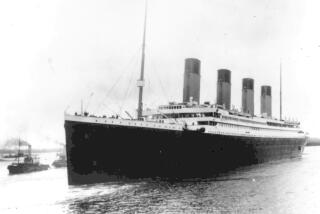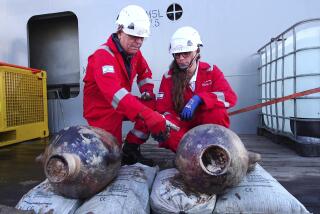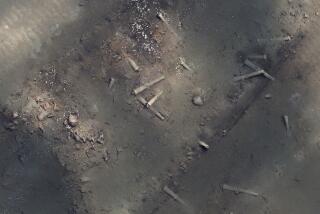Explorer follows ‘yellow brick road’ to sunken pirate treasure
Dorothy had to follow the yellow brick road to find her heart’s desire. Barry Clifford is following his own metaphorical yellow brick road, an underwater trail littered with gold and artifacts to find his heart’s yearning -- the treasure from a pirate vessel sunk in 1717 off of the coast of Massachusetts.
In 1984, Clifford discovered the site of the wreck of the Whydah and has since retrieved more than 200,000 artifacts, some of which are displayed in the Whydah Sea-Lab and Learning Center at the Whydah Museum in Provincetown, Mass. on Cape Cod. In his last dive, Clifford and his team told the Associated Press, they found evidence that could lead them to the treasure trove of the pirate ship, the only authenticated pirate wreck in U.S. waters.
PHOTOS: Shipwreck treasures -- amazing undersea finds
Clifford said he went to what he calls the “yellow brick road,” the gold- and artifact-strewn path extending between two significant sites at the Whydah wreck that are about 700 feet apart. The trove of coins and other treasure likely poured from the stern as the ship broke up and the stern drifted to its rest 300 years ago, he said.
“We think we’re very, very close” to finding the treasure, Clifford said.
Clifford’s quest will resume next summer. The treasure hunt also includes the prize of uncovering great wealth buried in murky waters as well as exploring an archaeological wonder that opens a window to the past.
The Whydah began life as a slave galley named for the west African port of Ouidah, once a center of the slave trade. It was captured by the pirate Black Sam Bellamy and made part of his fleet. Reportedly fat with treasure, the Whydah and another pirate ship heading to Cape Cod went down in foul weather.
The treasure aboard the Whydah consisted of gold and silver, including what was said to be 400,000 coins.
The team has recovered masses called concretions that are essentially a rocky overcoat formed around precious matter. X-rays show that there are coins inside some of the finds, including a cannonball piled with 11 coins and a foot-and-a-half-long piece of iron stacked with 50 coins.
“Did all of those coins just happen to fall on this one little piece of iron? Or were there thousands of coins there, and this is just an example of what’s left?’“ Clifford told the wire service.
Clifford said he is planning to return in June to resume his quest. His efforts were highlighted in a two-hour documentary aired on the National Geographic channel in 2008. He said he expects the wait to take its toll.
“I’ll wake up in the middle of the night this winter and go, ‘Oh my God, I know what that means,’ when I’m reviewing something from the Whydah,” he told the Associated Press. “And then I can hardly wait to get back here in the spring.”
ALSO:
Utah man acccused of planning attack on shopping mall
Baby Veronica, Cherokee girl, returned to adoptive parents
Final name crossed off missing persons list in Colorado floods
Follow L.A. Times National on Twitter
More to Read
Sign up for Essential California
The most important California stories and recommendations in your inbox every morning.
You may occasionally receive promotional content from the Los Angeles Times.











